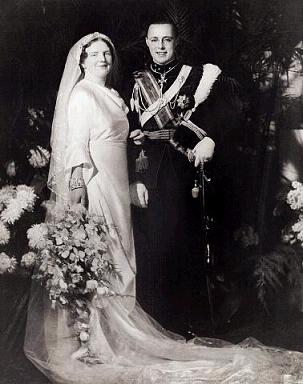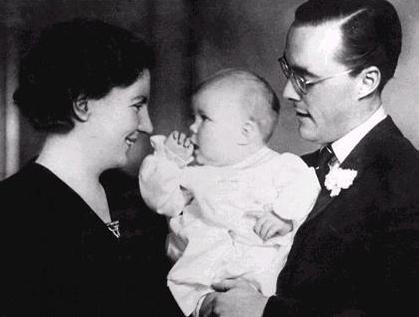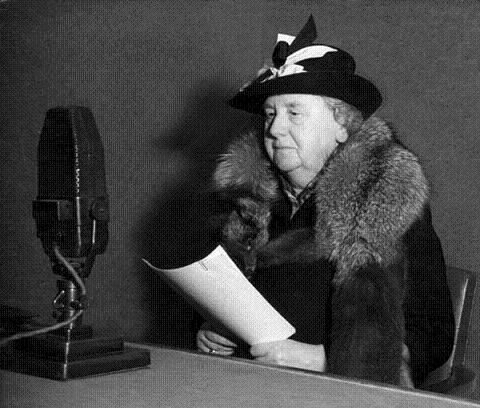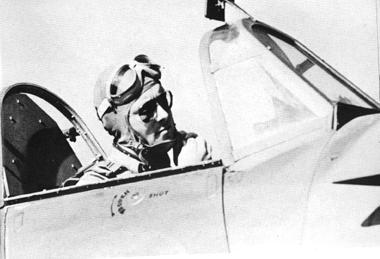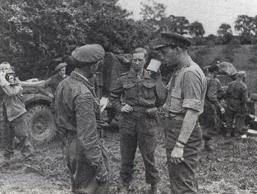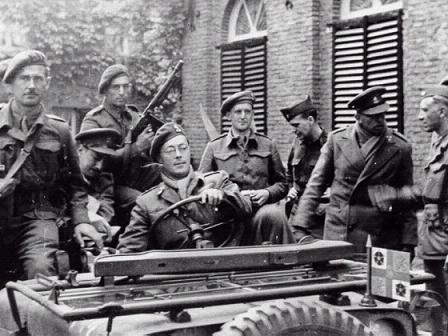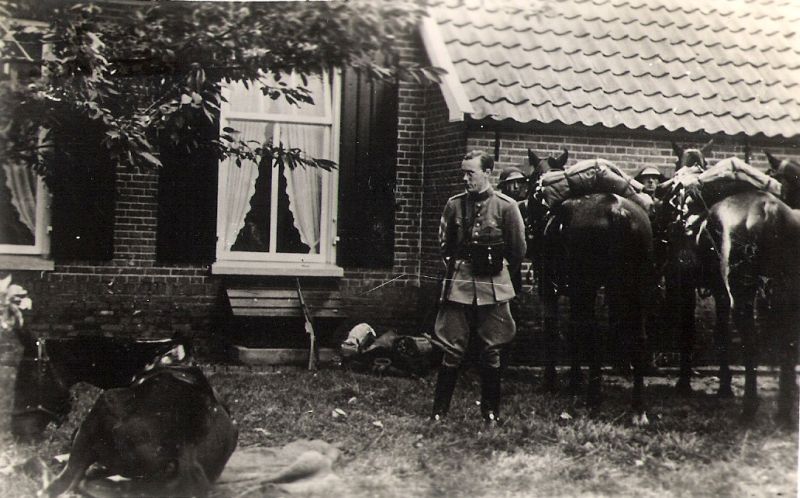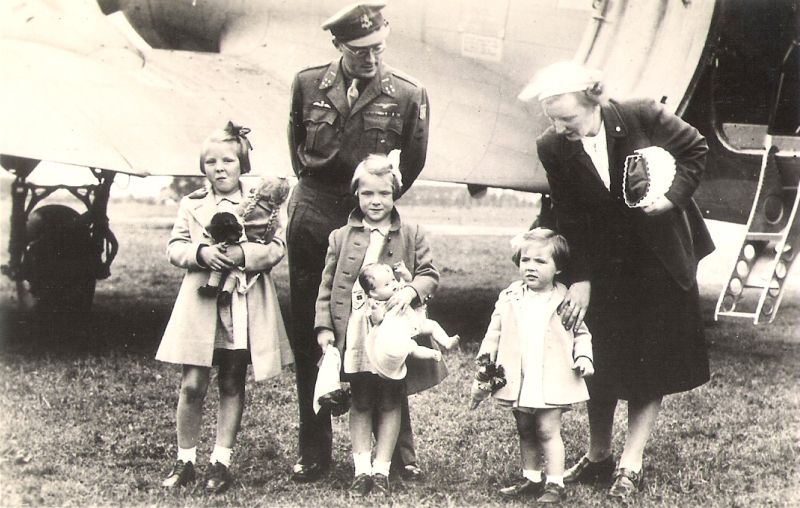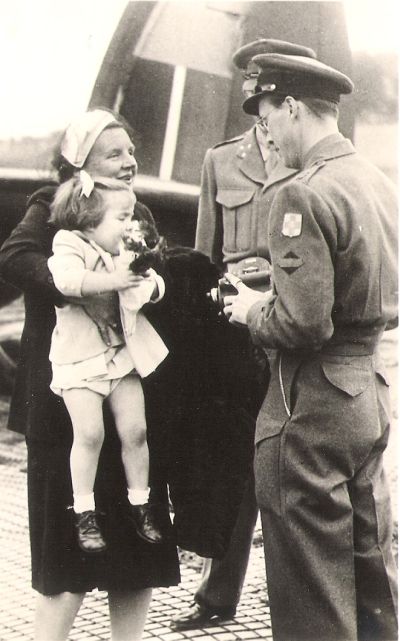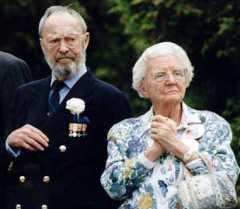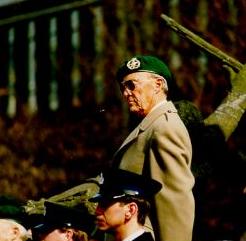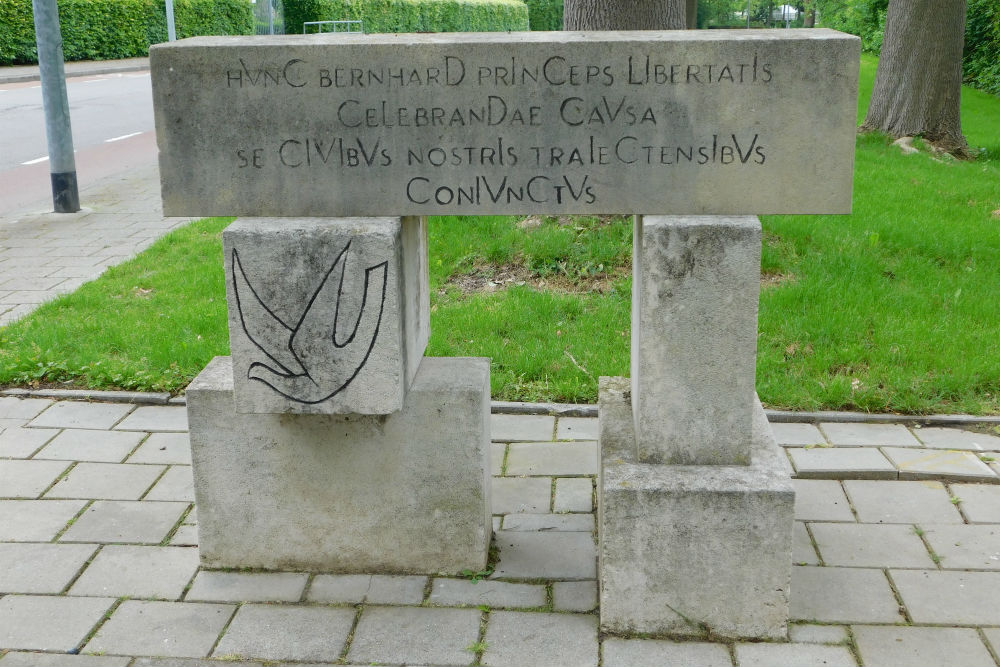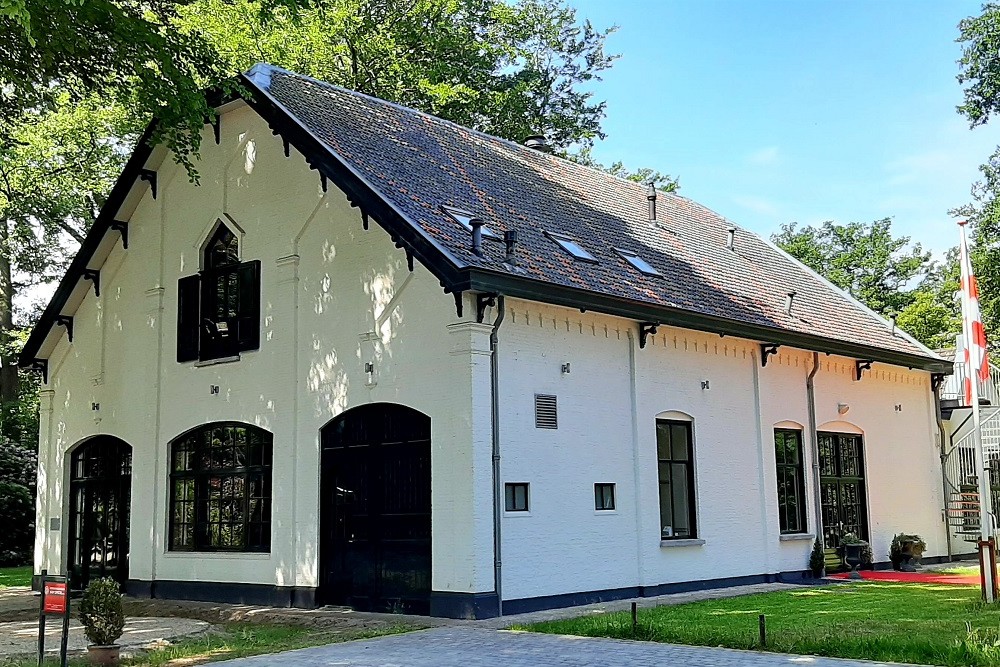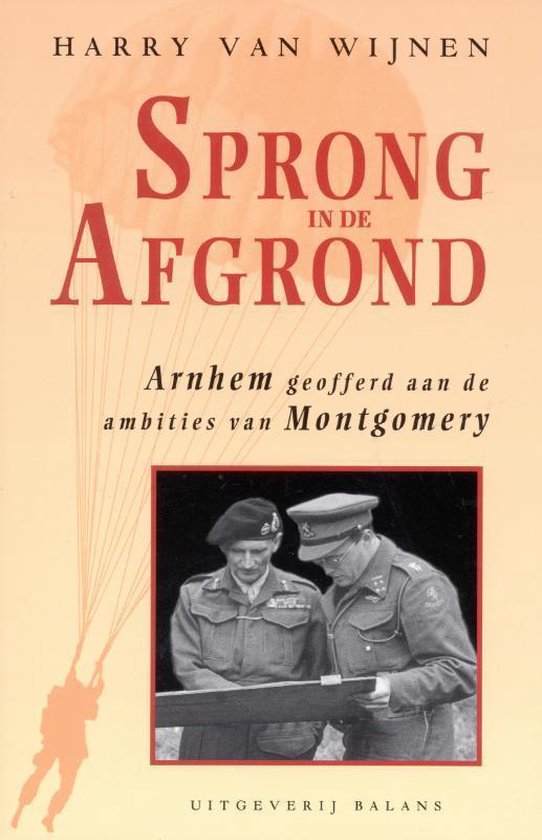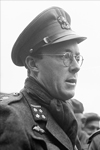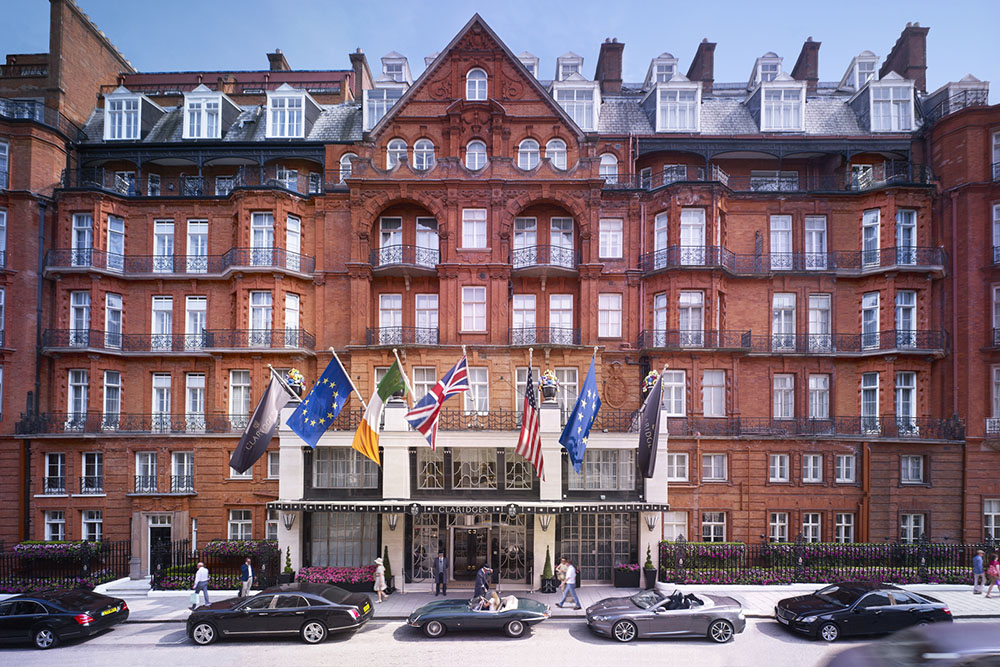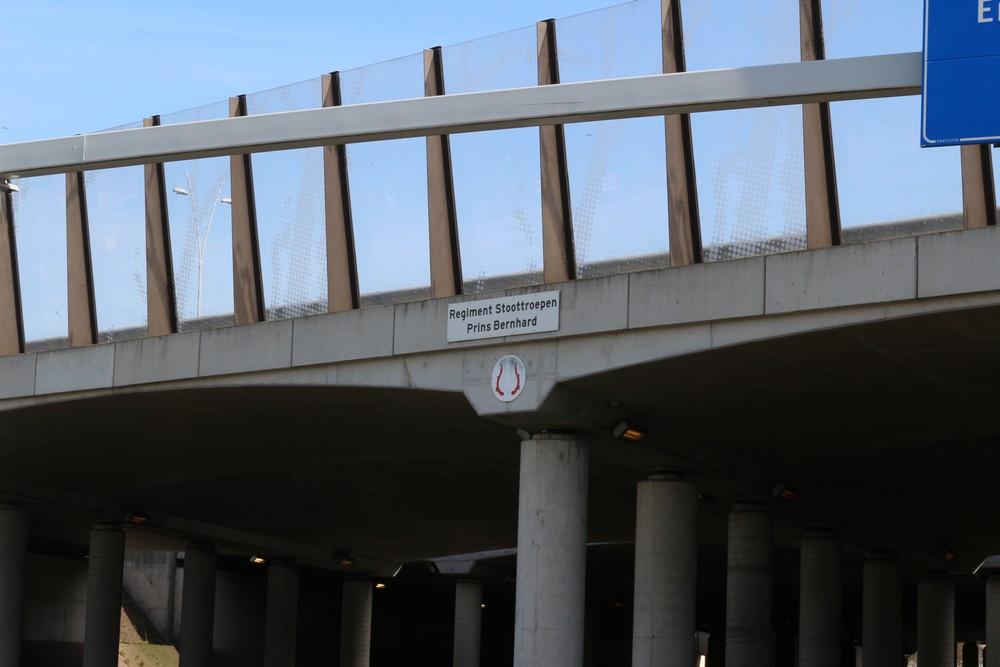Index
Prince Bernhard 1911 - 2004
In the evening of December 1st, 2004, Bernhard, Prince of the Netherlands, Prince of Lippe-Biesterfeld, passed away at the age of 93. Prince Bernhard married on January 7th, 1937, to Princess Juliana, later Queen of The Netherlands. During the Second World War Prince Bernhard rendered outstanding service to the Dutch case. After being transferred to England on May 12th,1940, he began to organize the Dutch refugees, who already escaped . He made sure that a Dutch RAF unit was established in 1942 and it was also the cradle of the "Regiment Stoottroepen" (a commando force). He was also closely involved in the "Princess Irene Brigade" and he was present at the surrender negotiations with the Germans, in the rank of commander of the Dutch armed and resistance forces.
During and after the war, Prince Bernhard got numerous awards for his achievements. On November 11th, 2004, the RVD announced that Bernhard was terminally ill. On November 29th, 2004, the statement was added, that the cancer already had spread to his intestines. In the evening of December 1st, the Prince was taken to the hospital, because his complaints could not be treated at the palace anymore. He died that night in the University Medical Centre in Utrecht.
Definitielijst
- Brigade
- Consisted mostly of two or more regiments. Could operate independently or as part of a division. Sometimes they were part of a corps instead of a division. In theory a brigade consisted of 5,000 to 7,000 men.
- RAF
- Royal Air Force. British air force
- Regiment
- Part of a division. A division divided into a number of regiments. In the army traditionally the name of the major organised unit of one type of weapon.
- resistance
- Resistance against the enemy. Often also with armed resources.
Images
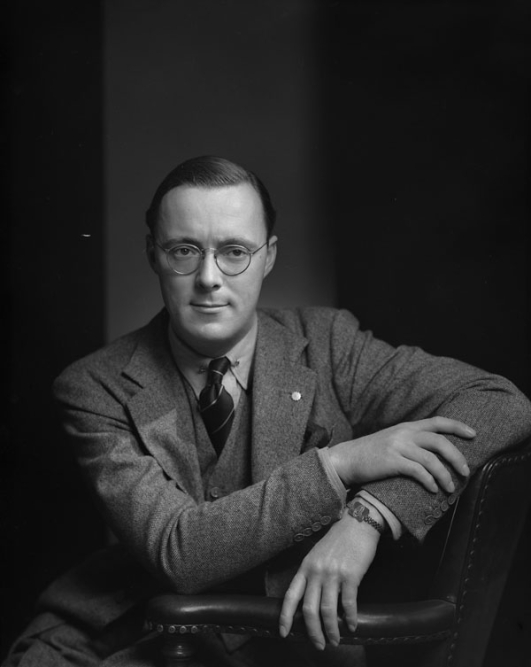 Prince Bernhard of the Netherlands, 1942. Source: Library and Archives Canada / public domain.
Prince Bernhard of the Netherlands, 1942. Source: Library and Archives Canada / public domain.Childhood and youth
Prince Bernhard was born on the 29th of June, 1911, in Jena (Germany) as the eldest son of Prince Bernhard von Lippe and Baroness Armgard von Sierstorpff-Cramm. He was endowed with a large number of names, that, when filling out forms anyway, had to lead to problems from time to time. His baptismal names are: Bernhard Leopold Friedrich Eberhard Julius Kurt Karl Gottfried Peter. In 1916 uncle Leopold, who was in power in Lippe, promulgated a decree in which he stated that, from then, his sister-in-law and her children would become prince or princess Zur Lippe-Biesterfeld. Prince Bernhard was not a prince until his fourth year.
The Prince spent his early childhood at the parental estate Reckenwalde in Brandenburg (now Woynowo, Poland), near the town of Züllichau (now Sulechow). Prince Bernhard got his early education at home. Already in his youth, he was fascinated by flying. At the age of 23, he took a few hours of flying lessons on a Klemm 25, a light aircraft from the 30s. However, during a low flight pass his plane dived into a pond. Prince Bernhard received a wet suit from this adventure and a bad cold. From now on, his parents did not allow him to fly anymore. A ban that the Prince clearly ignored ... In 1923, at the age of 12 he left for the boarding school of the Gymnasium in Züllichau. A few years later, the Prince went to the boarding school of a Berlin gymnasium, where he graduated in 1929. Bernhard studied law at the Universities of Lausanne, Berlin and Munich. In 1935, at the last university of Berlin, he passed his Master of Laws and obtained the title of Referendar Juris. At times, during his study, he lived it up seriously. According to witnesses, the parties Bernhard had, regularly made the old residence, in which he had his private dwelling, rock to its foundations.
During his Berlin study, in the early thirties, Bernhard was a member of the SA, the Sturmabteilung of Hitler's NSDAP. After studying the Prince entered into the service of the German chemical firm Interessen Gemeinschaft (IG) Farben. After a short training period, he became executive secretary at the Paris branch of this company, in 1935. During this period in Paris, Bernhard lived with Count and Countess Von Kotzebue, an uncle and aunt. He held this position until, on September 8th, 1936, he got engaged to Princess Juliana the Dutch heir whom he had met during the Winter Olympics in Garmisch Partenkirchen. In fact, the Dutch ambassador in Paris had urged Bernhard to pay a visit to Queen Wilhelmina and her daughter. Bernhard followed his advice and spent part of his winter holiday in the company of Princess Juliana. Then, he described young Juliana as "very sweet, very shy, very intelligent and very much under the influence of her mother." During their engagement and honeymoon that influence would decrease rapidly.
Prince Bernhard made the young Juliana acquainted with the modern life, including trips, parties and modern, chic clothing. Initially, Queen Wilhelmina seemed not to be appreciative of Bernhard’s dissolute lifestyle, but thawed slowly and then became even very fond of her future son in law. Although the public opinion in the Netherlands in 1936 was not yet pronounced anti-German, many people asked questions at Bernhard’s membership of the SA, but the Prince quite quickly reacted by stating that he positively disliked the National Socialists. On the occasion of the engagement , several Germans, living in the Netherlands, had put out the swastika flag. In The Hague such a flag had been lowered by the Dutch of which the German press put the blame on Bernhard and started a campaign against him.
On November 27th, 1936, Prince Bernhard was granted Dutch citizenship by law and shortly before his marriage to Princess Juliana on January 7th, 1937, the prince was sworn in to a number of military ranks. Thus, he was appointed Lieutenant-commander first class of the Royal Navy, Captain in the Royal Army and brevet Cavalry Captain of the Royal Dutch East Indies Army (KNIL) At his marriage, his surname 'Zur Lippe-Biesterfeld " was changed to "Of Lippe-Biesterfeld," and he got the title "His Royal Highness". Prince Bernhard and Princess Juliana would have four daughters. On January 31st,1938, Princess Beatrix was born and on August 5th, 1939, the birth of Princess Irene followed. The other two daughters, Princess Margriet and Princess Marijke (who later changed her name to Christina) were born on 19 January 19th, 1943 and February, 18th, 1947.
Definitielijst
- Cavalry
- Originally the designation for mounted troops. During World War 2 the term was used for armoured units. Main tasks are reconnaissance, attack and support of infantry.
- KNIL
- “Koninklijk Nederlands-Indisch Leger” meaning “Royal Netherlands East Indies Army” (1830-1950). Name of the Dutch army in the Netherlands East Indies.
- Sturmabteilung
- Storm detachment. Semi-military section of the NSDAP. Founded in 1922 to secure meetings and leaders of the NSDAP. Their increasing power was stopped during “The night of the long knives”, 29 and 30 June 1934.
- swastika
- Equilateral cross, symbol of Nazi-Germany.
Images
Second World War - the prince in London
In 1939, Prince Bernhard became aide-de-camp in special service of Queen Wilhelmina, Head of State of the Government in exile in London, a position he held until September 4th, 1948. But the military career of the Prince, however, was initiated especially during World War II. After the German invasion of the Netherlands in May 1940, the family went into exile to England, in the same month. Actually Bernhard did not like to flee from the Netherlands, because, to his opinion, he had to stay in the Netherlands since he was an officer in active service. What were the Dutch troops to think of him, when he, together with his family, would flee to England, in the heat of battle? It was only after Queen Wilhelmina had involved the Vice-President of the Raad van State, that Bernhard revised his view and in the evening of May 12th, the royal family left in an armoured car of 'De Nederlandsche Bank' (The National Bank). Later on, Prince Bernhard told about this trip: "The journey proceeded normally until IJmuiden, to the ferry. When we were on the ferry, a German aircraft passed overhead. Although, initially, the German aircraft did not do anything, the marines at the ferry started to fire at the plane and I remember that this is the only time in this war where I said “do not fire”, because if a bomb would be thrown on the ferry, the car with my wife and kids in it would irrevocably go down and that was certainly not something we would have wanted".
On May 13th, 1940, Princess Juliana and Prince Bernhard, arrived in London, together with the Princesses Beatrix and Irene. Subsequently, one month later, Juliana and her children left for the Canadian capital Ottawa for safety reasons. Prince Bernhard visited his family several times here, during the war. However, most of the time he stayed in London, where Queen Wilhelmina with the Dutch government stayed in exile. During his years in London, the Prince kept in close contact with his mother-in-law. As long as governmental affairs were in preparation, she never never informed him, but, as he told Loe de Jong in 1957, "Gradually, sometimes things were told to me later on, after they had happened. As for me, I told the queen all I heard". Of course, the business of which Bernhard had to be informed in case Queen Wilhelmina would pass away, were of a confidential nature. (Loe de Jong was a Dutch historian and journalist, who wrote a lot of history books about the Second World War. He was also director of the National Institute for War Documentation from 1945 until his retirement in 1979.)
Initially, Prince Bernhard was distrusted in London by MI5 (British Intelligence). Finally, he was of German descent and this could be a reason why the prince was not always informed on all state affairs beforehand. Bernhards military efforts on the Allied side during the second World War made him a hero in the eyes of many people. After the capitulation, in May 1940, many fled the Netherlands and emigrated to England in order to commit themselves to the battle against the German occupying forces. Soon the idea emerged to form an all Dutch air force unit within the RAF and one of the major initiators of this plan was Prince Bernhard. Due to his personal effort in July 1942, a Dutch 'Flight' was formed within the No.167 Squadron, which was established in April of the same year. Although the Dutch squadron concerned was never fully manned with Dutch crews, the No.167 Squadron was dissolved on June 12th, 1943 and the No. 322 (Dutch) Squadron was officially established.
Also, during the war, Prince Bernhard was directly involved in the establishment of the Dutch Regiment Stoottroepen. He personally instructed resistance fighter Peter Borghouts to put together military units from the members of the local resistance fighters. These units became the Stoottroepen. In fact, in 1944, in the already liberated south of the Netherlands these resistance fighters were eager to help liberate the north of the Netherlands. On the 21st of September 1944, Prince Bernhard, in his role as Commander of the Binnenlandse Strijdkrachten (domestic forces), gave the command to form military units from this group liberated resistance fighters. Even then he decreed the name Stoottroepen. Prince Bernhard remained closely involved with the Regiment Stoottroepen, which became very clear on June 28th, 2002, when he presented a cravatte (a kind of pennant) for the banner of the Stoottroepen. The long strip of cravatte reads “Regiment Stoottroepen Prins Bernhard”, while the short strip mentioned “29-6-2002”. The award ceremony took place on the steps of Soestdijk Palace.
The prince achieved his military pilot's license during his stay in London. Subsequently, in September of that year, he was appointed head of the Dutch Military Mission, a kind of intermediary between the Secretary of War and the British War Office. Also the prince had frequent contact with Dutch soldiers and he did not hesitate to fly over enemy territory, during air raids. He was very eager to participate in operations over Europe. Although the Queen had strictly forbidden him to do so, he did it anyway in 1944: three times as a crew member of a U.S. bomber (during operations over France and Italy), and several times as a pilot of an American single-seat- fighter. For all those flights, his true identity was concealed in view of the danger to fall into German hands as a prisoner. He pretended to be an officer of the British Royal Air Force, named Wing Commander Gibbs. In 1941 he received the rank of Honorary Air Commodore in the Royal Air Force (RAF), a rank which was changed to Honorary Air Marshall in 1964. Eventually, in 1943, Queen Wilhelmina promoted him to Lieutenant General and Vice Admiral.
Several times, the prince travelled outside England. In 1942 he was in Ottawa three times to visit his family and he linked his third visit, which began late September, together with a journey to New York, Washington, the Antilles and Suriname and before flying back from Washington, he visited still a number of other places in the United States. In January 1943, Bernhard visited Ottawa again, because of the birth of Princess Margriet. From there he flew to Cairo and from Cairo to the headquarters of General Bernard Montgomery in Libya and to General Dwight Eisenhower in Algiers. These flights were not not always without danger, which became evident, during his fifth visit to Ottawa, late 1943. During the return trip to England, one of the four engines of the bomber, flown by Bernhard, fell out which caused the the tail of the aircraft to tremble and sway. Yet he managed to keep the aircraft in the air for four hours and eventually landed safely in Northern Ireland. Once he was safely on the ground he became aware that he really had been in danger and the true reaction actually came several days later when he told Van Lidth, the Minister of War,: "For now I have enough of flying."
Definitielijst
- capitulation
- Agreement between fighting parties concerning the surrender of a country or an army.
- heat
- High-explosive anti-tank warhead. Shaped charge projectile to punch through armour. Used in e.g. bazooka or in the Panzerfaust.
- invasion
- Armed incursion.
- RAF
- Royal Air Force. British air force
- Regiment
- Part of a division. A division divided into a number of regiments. In the army traditionally the name of the major organised unit of one type of weapon.
- resistance
- Resistance against the enemy. Often also with armed resources.
- Squadron
- A military unit in the Belgian navy usually six to eight small ships operating together under one command. The smallest military unit in the Dutch air force of about 350 men. In most countries is the designation of a military unit thesize of a company. It is either an independent unit, such as a battery, or part of a bigger Calvary unit. In the air force it is the designation of a unit of aircrafts.
Images
Second World War - the prince as commander of the NBS
After the war there was a rumour that Prince Bernhard was supposed to have written a letter to Hitler and Himmler in 1942. In this letter, which later became known as the "Stadhoudersbrief” (Stadtholder-letter), he allegedly offered his services and made a peace proposal to them in which he was to act as Stadtholder of the Netherlands, on behalf of Hitler. However, the prince has always vehemently denied the existence of this letter which led to a deap-seated frustration about this story. However, the frustration of the prince about the letter is understandable, because the letter is untraceable and the question is whether the letter exists at all. Therefore he confidently offered an award of one million Dutch guilders for it.
At that time, Queen Wilhelmina strongly pled the cause to have Bernhard appointed commander in chief of the army and navy. She considered the fact surmountable whether this function might bring Bernhard, being a member of the Royal Family, in a vulnerable position. However, the Dutch government disagreed and, moreover, was of the opinion that Bernhard lacked the required training. Although Queen Wilhelmina continued to exert strong pressure, the ministers did not agree. However, in the spring of 1944, the Dutch monarch, read an article about General Koenig, who was appointed commander of the Forces Françaises de l'Intérieur . She immediately saw immediately that for the Dutch counterpart, the Nederlandse Binnenlandse Strijdkrachten, something like that ought to happen and commended her son in law for this. It would still take some time, but on the 3rd of September 1944, it finally came to it and Prince Bernhard entered into his new role as Commander of the Dutch Forces.
On the 7th of September, 1944 Bernhard insisted with Field Marshal Bernard Montgomery to invade the Netherlands that same week. Although no minutes were kept of this discussion between the Dutch Commander and the British Field Marshal, Bernhard had written a few notes in his diary. The prince namely had received vital information from the occupied Netherlands, regarding Operation Market Garden, but Montgomery made short work of this advice and warnings from the Dutch prince, in an unambiguous way. Later on, Prince Bernhard wrote the following about this: "He believed none of the reports from my Dutch officers, which proved, later on, to have been very accurate. Montgomery found the reports concerned, which were made in the first week of September, not important or relevant enough. If he had struck then, he would have been able to conquer all German resistance in the targeted area in one hit, because at that time there were almost no German forces around Arnhem. A week later, the German reinforcements arrived in Arnhem".
Then, Prince Bernhard also uttered some warnings regarding the “weak spots” in the operation. He warned Montgomery that the area between Grave and Arnhem was not suitable for a tank battle, because it was a landscape with plenty of water and obstructions (such as bridges) and the route the Allies planned to follow was too narrow for such a massive allied column. Montgomery did not wish to see the danger of the well-meaning advice and called it off as amateurism. This shows that Prince Bernhard, despite his position as Dutch Commander, was not regarded as sufficiently experienced by the British. Moreover, Montgomery also thought him to be an amateur, someone who did not earn his rank on the battlefield, but it had been given to him. This mutual dislike between the two men remained there forever and when Bernhard wrote him a letter about this issue, many years later, he never received a reply from Montgomery.
Besides, the Dutch Queen remained persisting in her opinion that her son in law should be appointed Supreme Commander at a later date. However it would never come to that extent and finally Lieutenant General Kruls (who before that had led the Military Authority)got the function in his place. Prince Bernhard would retain the position of commander of the Nederlandse Binnenlandse Strijdkrachten until the 13th of September, 1945. In this capacity Bernhard was present in May 1945, when the Germans signed the capitulation at the Wageningen hotel “De Wereld”. Later on, in a television program of L. de Jong, Prince Bernhard said, among other things,: "We arrived there on the 30th of April and this has been the first time since 1936 that I forgot my wife's birthday, because we were occupied with what we had to do, neither my officers, nor I have thought of it". On the 13th of September 1945, after the liberation of the Netherlands had led to the abolition of the Nederlandse Binnenlandse Strijdkrachten, Prince Bernhard was honorably relieved of his command and in its place he was appointed Inspector-General of the Army (IGKL).
During the five years in Great Britain, Queen Wilhelmina as well as Prince Bernhard had both been very dedicated to the allied cause. Prince Bernhard had been of great support to his mother in law in London. Furthermore, although some British initially were somewhat suspicious of him because of his German origin, he made sure that the screening of refugees from the Netherlands became a Dutch matter. Thanks to his fast growing popularity in Britain, the Prince Bernhard Fund was established soon, whereupon the prince initiated the foundation of the Spitfire Fund, which collected funds for the purchase of fighter aircraft. Consequently, thanks to this fund, Churchill received the money for not less than nine Spitfires offered by Bernhard on his birthday in 1940.
In August 1945 the royal family was reunited on Dutch soil. In 1946 the Prince received the highest military decoration: the Commandeurskruis der Militaire Willemsorde, for his services during the Second World War. For his activities as a war pilot, he was awarded the Vliegerkruis. In 1984, the Prince also received the Resistance Cross. From British side as well as from French, American, Belgian, Greek and Czechoslovakian side, Prince Bernhard was distinguished for his war efforts. In 1946 and 1953 the appointment of Inspector-General of the Royal Navy and Royal Air Force followed.
The prince found his motivation and satisfaction with the troops of the Dutch armed forces and the British RAF. The prince was worshiped by them and especially by the men with lower ranks. Also he could get along very well with officers below the rank of colonel, but over that rank a barely noticeable abstention got in his attitude. It was not that he had something against generals and admirals, basically, but from experience he learned that these bigwigs often tried to use him for their own purposes. Naturally open and trusting, he was exposed to manipulation and unlike Queen Wilhelmina who never gave somebody just more than one chance, he was inclined to remain loyal to those who abused him, for a long time. Loyalty was his strong side, but also it was his weakness and friendship was his highest good. His dislike of bureaucracy and intrigue drove him from London to the fair comradeship of men who like himself, preferred action and adventure. In his heart he was jealous of the ordinary soldier, who was in direct contact with the enemy. But the happiest he felt near aircraft and pilots. He knew no fear and if he had to choose, he would have spent the rest of the war in a Spitfire.
A story, with which Prince Bernhard always was associated, was the old King Kong story. King Kong, or Christiaan Lindemans, was the so-called traitor of the Battle of Arnhem in September 1944. As a double agent, this Lindemans gave away the plans of the Allied airborne troops, to conquer Arnhem, to the German Abwehr. And precisely because of the leaking of this top secret information, hardened Waffen SS units were stationed in Arnhem to repel the attack of the British paratroopers. This betrayal would (with the emphasis on would) have been possible because, at the headquarters of Prince Bernhard, Lindemans had free access to highly classified information. Actually, this has never been proven, but this story will always remain connected to Bernhard. Anyway it is a fact that the Dutch government has tried for years to cover up all correspondence in the “'King Kong” case and Prince Bernhard's alleged involvement. In February 2004, the prince settled with these allegations and accusations through a letter in the Volkskrant (a national newspaper) and he even called in the help of Winrich Behr, who was the staff officer of General Erwin Rommel, during the war.
Another rumour that always has haunted the prince is that, before the outbreak of the Second World War, he would have been a member of the National Socialist German Labour Party (NSDAP). This rumour, which was brought to light by an employee of the Dutch RIOD (presently NIOD, the Dutch National Institution for War Documentation) who had discovered this information in the National Archives in Washington, however, was denied fervently by the prince. At a certain moment he even summoned the RIOD employee concerned to the Soestdijk Palace and told him finally that in 1933 someone else had put him on the NSDAP list.
Definitielijst
- Abwehr
- Term used for the German military intelligence unit during the WW1 and WW2. From 1935 onwards under command of Admiral Wilhelm Canaris. The organisation often came into conflict with other secret services such as the SD and the Gestapo. During World War 2 under Canaris frequently a source for conspiracies against the Nazi regime until in 1943 a major conspiracy by a number of prominent members of the Abwehr was discovered and the Abwehr was placed under command of Himmler. After the assassination attempt on Hitler in 1944, Canaris was discharged and the Abwehr was dissolved. The conspirators and Canaris were prosecuted and in 1945 they were executed atc oncentration camp Flossenburg.
- capitulation
- Agreement between fighting parties concerning the surrender of a country or an army.
- King Kong
- Dutch (double) agent. Real name Christiaan Lindemans(1912-1946), suspect role in possible treason of the plans of Market Garden and his relationship with Prince Bernhard.
- Marshal
- Highest military rank, Army commander.
- Military Authority
- Dutch military body with special authority on non-military issues (1944 – 1946).
- paratroopers
- Airborne Division. Military specialized in parachute landings.
- RAF
- Royal Air Force. British air force
- resistance
- Resistance against the enemy. Often also with armed resources.
Images
After the war
After the Second World War the prince played an important role in the economic reconstruction of the Netherlands. To promote the Dutch trade relations, he made goodwill trips to many countries. Prince Bernhard is also founder and regent of the Prince Bernhard Fund. This fund was established in 1940 in London. Initially the Prince Bernhard Fund intended to raise money to support the war efforts of the Allies. After the war this objective changed into the support of culture, science and conservation of nature in the Netherlands. In 1999 the name of the Fund changed to the Prince Bernhard Culture Fund. Next to the Amsterdam-based rural Culture Fund, fifteen departments are located in the provinces and the cities of Rotterdam and The Hague have their own Culture Fund as well. Annually, the prince presented a number of cash prizes to artists and scientists on behalf of the Culture Fund and every summer he presented the Silver Carnation to people who have voluntarily devoted themselves in the cultural field for a long time.
An event in his post-war life that will always haunt the prince is called the Greet Hofmans affair. The state of health of Princess Marijke (renamed Christina), who had a serious visual handicap, had always been a source of worry to both Queen Juliana and Prince Bernhard. Therefore, in the spring of 1948, Prince Bernhard engaged the help of faith healer Greet Hofmans. Her presence at Soestdijk palace caused a deep crisis at the court, in the fifties, which divided the palace into two camps. Prince Bernhard lost his faith in the healing methods, but Queen Juliana remained confident in Greet Hofmans. Eventually, after the intervention of a committee of wise men, Hofmans had to leave Soestdijk.
Prince Bernhard was regent of the Praemium Erasmianum Foundation, which he founded in 1958. Annually, the Foundation decorates persons or institutions, which were meritorious, particularly for Europe, on the field of culture, society or social science in Europe. Over the years the Erasmus Award has been granted to, amongst others, Jan Tinbergen (1967), Amnesty International (1976), Vaclav Havel (1986), Simon Wiesenthal (1992), Jacques Delors (1997) and Hans van Maanen (2000). With the amount of € 150.000, the Erasmus Award is the largest cultural Award in the Netherlands.
From 1956 to 1977, Bernhard was President of the European Cultural Foundation, founded in 1954 in Geneva by "the father of the European Community”, Robert Schumann, and is based in Amsterdam since 1960. The Foundation promotes European cooperation in the field of education and arts, environment, social issues and cultural relations between Eastern and Western Europe.
Prince Bernhard was very dedicated to nature conservancy. In 1961 he was co-founder of the World Wildlife Fund (WWF). The WWF is active worldwide in the field of nature conservation. He is committed to conservation of flora and fauna, extending nature and improving environment. As president of the WWF, the prince regularly visited countries in Asia, Africa and South America. After his resignation in 1977 the prince was appointed Founder President. He remained associated with the WWF and he was President of the Dutch branch of the World Wildlife Fund, until his death. Furthermore, in 1971, Prince Bernhard established the Order of the Golden Ark to distinguish persons, who are particularly meritorious for the conservation of flora and fauna.
After his name became associated with bribes by the Lockheed aircraft factories in 1975, the Government of prime-minister Den Uyl instituted the Committee of Three, on the 9th of February 1976. This committee had to carry out a detailed investigation into the accuracy of this matter. Between 1960 and 1962, Prince Bernhard allegedly received commissions, worth a million dollars, and in 1974 he allegedly would have asked for even more. However the inquiry concluded that Prince Bernhard indeed did get "engaged in relationships and circumstances that were not acceptable". Partly in response to the final conclusions of this report, he apologized for his actions and subsequently he resigned from all military functions (including wearing military uniforms) and from his functions in trade and industry. Moreover it was decided not to prosecute, on the one hand, because barred facts were involved and on the other hand to avoid a constitutional crisis. During an interview with the NOS (Dutch Broadcast Foundation) he stated to have "a completely clear conscience" and he was nothing to blame for in connection with “the Lockheed affair”.
In recent years the prince regularly stayed at the Utrecht University Hospital (AZU) for various operations. The strong constitution of the prince was confirmed by the many diseases which he had been able to overcome and the many operations he had undergone, during his entire live. The last few years, Prince Bernhard decided to take it easy. Thus, in June 1994 after 53 years of flying and 12,000 flight hours, he made his last flight and at his farewell flight he even performed a roll over over Schiphol. As long as his health permitted, Prince Bernhard took the annual parade on the national liberation day in Wageningen, much to the satisfaction of many veterans. For the veterans, this memorial was something to look forward to all year, as well as for Prince Bernhard, who, to the delight of many, did wear his green beret during the last parade. The prince was seen as the symbol of the Dutch resistance.
His wife, Princess Juliana, died on the 20th of March, 2004, from the effects of pneumonia, combined with the overall weakness of her constitution. Four daughters, fourteen grandchildren and several great-grandchildren were his progeny now. He had a very good relationship with all of them and all paid him a visit in Italy regularly, when the prince spent the summer there. Despite many (physical) setbacks, scandals and speculations, Prince Bernhard never got disconcerted. Even in the darkest years of the Second World War, in London, he managed to retain his spirit. Later on, the British King George VI said about him: "Of all the people I know, Prince Bernhard was the only one who enjoyed the war".
On the 11th of November 2004, the RVD (Government Information Service) announced that Bernhard was terminally ill. On the 29th of November 2004, it was added that the prince already had metastases of his intestines. In the evening of the 1st of December, he was taken to the hospital, because, due to his complaints, he could not be nursed at the palace anymore. That night, the prince died in the University Medical Centre in Utrecht.
Definitielijst
- resistance
- Resistance against the enemy. Often also with armed resources.
Images
Received awards and insignia
- Received awards and insignia
- Commandeur Militaire Willemsorde on June 15th, 1946.(Commander of the highest Dutch Military Distinguishment)<>/li>
- Grootkruis Orde of the Nederlandse Leeuw.(Cross of the Dutch Lion, the highest civilian order of merit)
- Grootkruis Huisorde of the de Gouden Leeuw van Nassau in 1951.(Cross of the Golden Lion of Nassau)
- Vliegerkruis. ( Dutch DFC)
- Oorlogsherinneringskruis met twee gespen.(War memorial cross with two clasps)
- Verzetsherdenkingskruis in 1984. (Resistance memorial cross)
- Insignia for long service.
- Grand Cross in the Order of the British Empire.
- Grootkruis Legioen van Eer.
- Oorlogskruis met palmtakken
- Officer ranks
- Luitenant-ter-zee eerste klasse à la suite* Koninklijke Marine from December 3rd, 1936.
- Kapitein Koninklijke Landmacht from December 3rd, 1936.
- Kapitein-ritmeester titulair K.N.I.L.
- Honorary Air Commodore R.A.F. from 1941 to 1964.
- Schout-bij-Nacht from May 25th, 1942 to December 15th, 1943.
- Generaal-majoor Koninklijke Landmacht from May 25th, 1942 to December 15th, 1943.
- Luitenant-generaal K.N.I.L. from December 15th, 1943.
- Luitenant-generaal Koninklijke Landmacht from December 15th, 1943.
- Vice-admiraal titulair from December 15th, 1943.
- Honorary Air Marshall R.A.F. from 1964.
- Honorary Air Commodore Royal New Zealand Air Force.
- Generaal Koninklijke Landmacht until September 9th, 1976.
- Generaal-vlieger Koninklijke Luchtmacht until September 9th, 1976.
- Luitenant-admiraal Koninklijke Marine until September 9th, 1976.
- * = the term à la suite means exceeding de formation strength, meaning that it actually is a honorary function
Definitielijst
- Resistance
- Resistance against the enemy. Often also with armed resources.
Information
- Translated by:
- Chrit Houben
- Published on:
- 19-01-2025
- Feedback?
- Send it!
Related sights
Related books
Sources
- Bericht van de Tweede Wereldoorlog, Amsterdam Boek, Amsterdam, 1970.
- HILTERMAN, MR. G.B.J, Geschiedenis van de Tweede Wereldoorlog, Bosch & Keuning, Baarn, 1994.
- HOEK, K.A. VAN DEN, De Tweede Wereldoorlog Lekturama-serie, Lekturama, Rotterdam, 1978.
- JONG, L. DE, De Bezetting, SDU, Den Haag, 1990.
- JONG, L. DE, Het Koninkrijk der Nederlanden in de Tweede Wereldoorlog, Staatsuitgeverij, Den Haag, 1972.
- KIKKERT, J.G., Pins Bernhard 80 jaar, Het Spectrum, Utrecht, 1991.
- KLINKENBERG, W., Prins Bernhard, een politieke biografie, In de Knipscheer, Haarlem, 1986.
- WIJNEN, H. VAN, Sprong in de Afgrond, Uitgeverij Balans, Amsterdam, 1994.
